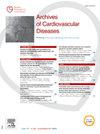使用机器学习预测st段抬高型心肌梗死后5年死亡率的性别特异性模型:来自FAST-MI注册表的见解
IF 2.3
3区 医学
Q2 CARDIAC & CARDIOVASCULAR SYSTEMS
引用次数: 0
摘要
大多数急性心肌梗死(AMI)的预后分层工具都来自人群,包括女性和男性,只有一小部分女性。目的:使用监督机器学习(ML),我们评估了两种AMI后5年死亡率预测模型的性能,分别来自男性和女性,以确定性别特异性模型是否改善了结果预测。方法本队列研究采用法国急性st段抬高和非st段抬高心肌梗死登记处(FAST- MI) 2010年和2015年的调查。这项多中心登记在法国200多家医院开展,在1个月的招募期内招募了所有连续的急性心肌梗死患者。我们的分析包括所有接受有创冠状动脉造影(ICA)的STEMI患者。为了建立和验证模型,数据集以70%/30%的比例分为训练集和测试集。主要结局为5年全因死亡率。然后,使用Boruta算法评估52个临床、实验室、心电图、超声心动图和ICA参数进行特征选择。评估了不同的监督机器学习算法,包括随机森林(RF),用于模型构建,并比较了它们在女性和男性中的表现。结果连续纳入STEMI患者1189名女性和3685名男性(平均年龄分别为61±13岁和69±15岁);12%的男性和20%的女性经历了5年的全因死亡率。使用Boruta算法,选择10个最重要的预测变量(图1)。对于基于女性的ML模型构建,RF算法在预测死亡率方面表现最佳,接受者-工作特征曲线(ROC-AUC)下面积为0.82 (95% CI: 0.77-0.88),精确度-召回率曲线(PR-AUC)下面积为0.59 (95% CI: 0.54-0.64);f1得分为0.58。基于女性的ML模型在男性中表现较差(ROC-AUC: 0.78;PR-AUC: 0.43)。相反,以男性为基础的模型在男性身上比在女性身上表现出更高的准确性。结论:在STEMI患者的大型多中心队列中,基于女性和男性的ml模型在预测5年全因死亡率方面表现出良好的准确性,但应用于其他性别时准确性下降。这表明,性别特异性模型可能优于一般模型来预测AMI后的死亡率。本文章由计算机程序翻译,如有差异,请以英文原文为准。
Sex-specific models to predict 5-year mortality after ST-elevation myocardial infarction using machine learning: Insight from FAST-MI registry
Introduction
Most prognostic stratification tools in acute myocardial infarction (AMI) have been derived from populations including both women and men with only a small proportion of women.
Objective
Using supervised machine learning (ML), we assessed the performance of 2 models for 5-year mortality prediction after AMI, derived from men and women, to determine whether sex-specific models improved outcome prediction.
Method
This cohort study used the French registry on acute ST-elevation and non-ST-elevation myocardial infarction (FAST- MI) 2010 and 2015 surveys. This multicentric registry led in more than 200 French hospitals, enrolled all consecutive patients with acute myocardial infarction during a 1-month recruitment period. Our analysis included all men and women presenting STEMI who underwent invasive coronary angiography (ICA). To build and validate the models, the data set were split with a 70%/30% ratio into training and testing sets. The primary outcome was 5-year all-cause mortality. Then, 52 clinical, laboratory, ECG, echocardiographic, and ICA parameters were evaluated for feature selection using Boruta algorithm. Different supervised machine learning algorithms, including random forest (RF), were assessed for model building, and their performance were compared in women and men.
Results
1,189 consecutive women and 3,685 men with STEMI (mean age 61 ± 13 and 69 ± 15 years, respectively) were recruited; 12% of men and 20% of women experienced 5-year all-cause mortality. Using Boruta algorithm, the 10 most important variables for prediction were selected (Fig. 1). For women-based ML model building, the RF algorithm exhibited the best performance to predict mortality with an area under the receiver-operating characteristic curve (ROC-AUC) of 0.82 (95% CI: 0.77–0.88), an area under the precision-recall curve (PR-AUC) of 0.59 (95% CI: 0.54–0.64); and a F1-score of 0.58. The women-based ML model exhibited lower performance in men (ROC-AUC: 0.78; PR-AUC: 0.43). Conversely, the men-based model exhibited better accuracy in men than in women.
Conclusion
In a large multicentric cohort of STEMI patients, women- and men-based ML-models exhibited a good accuracy to predict 5-year all-cause mortality with a drop of accuracy when applied to the other sex. This suggests that sex-specific models might be superior to general models to predict mortality after AMI.
求助全文
通过发布文献求助,成功后即可免费获取论文全文。
去求助
来源期刊

Archives of Cardiovascular Diseases
医学-心血管系统
CiteScore
4.40
自引率
6.70%
发文量
87
审稿时长
34 days
期刊介绍:
The Journal publishes original peer-reviewed clinical and research articles, epidemiological studies, new methodological clinical approaches, review articles and editorials. Topics covered include coronary artery and valve diseases, interventional and pediatric cardiology, cardiovascular surgery, cardiomyopathy and heart failure, arrhythmias and stimulation, cardiovascular imaging, vascular medicine and hypertension, epidemiology and risk factors, and large multicenter studies. Archives of Cardiovascular Diseases also publishes abstracts of papers presented at the annual sessions of the Journées Européennes de la Société Française de Cardiologie and the guidelines edited by the French Society of Cardiology.
 求助内容:
求助内容: 应助结果提醒方式:
应助结果提醒方式:


